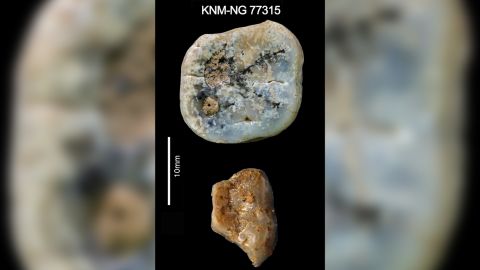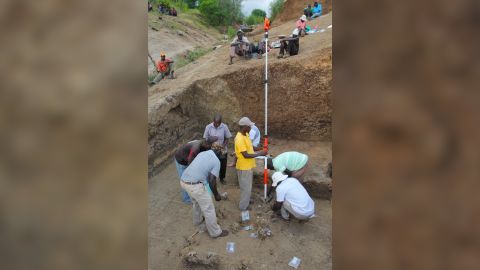Sign up for CNN’s Wonder Theory science newsletter. Explore the universe with news on fascinating discoveries, scientific advancements and more.
CNN
—
The discovery of 330 stone artifacts in Kenya that date back 2.9 million years is throwing light on a key question in human evolution — who first used stone tools?
Scientists unearthed hammerstones, cores and flakes, and the bones of butchered hippos and two teeth belonging to an ancient humanlike ape known as Paranthropus, from eroded slopes along the shore of Kenya’s Lake Victoria at a site called Nyayanga on the Homa Peninsula.
The discovery of a Paranthropus upper and low molar at Nyayanga has undermined the assumption that only humans could make these types of tools.
“While some species of nonhuman primates produce technologies that assist in foraging, humans are uniquely dependent on technology for survival. But the evolutionary origins of this reliance on technology for survival is shrouded in mystery,” said Tom Plummer, a professor of anthropology at Queens College, City University of New York, and coauthor of the research.
The most ancient known stone tools are thought to be 3.3 million years old and were discovered at a site called Lomekwi 3, also in Kenya. However, the stone tools unearthed at Nyayanga were more sophisticated than the rudimentary ones found at Lomekwi 3 and belong to a style that had been closely linked to the emergence of the Homo genus that includes our own species, Homo sapiens.
Systematically, rather than haphazardly, produced, the stone implements would have allowed ancient hominins to cut through the thick skin of large animals, slice off pieces of meat and break open bones for marrow, as well as mash plant material to make it more palatable, Plummer explained. Hominins were once a diverse group of humans and humanlike apes.
Study coauthor Rick Potts, a paleoanthropologist and Peter Buck Chair of Human Origins at the Smithsonian National Museum of Natural History in Washington, DC, described the tool kit as “the first simple food-processor.”
“The sharp-edged flakes could cut as effectively than a lion’s set of teeth, and the hammerstones could crush as effectively as an elephant’s molars — and thus all of possible foods of the savanna woodlands/grasslands were opened up to processing with this new set of teeth outside of the body,” he said via email.

Prior to this new study, published in the journal Science on Thursday, the earliest known appearance of this style of tools was in the Afar Triangle of Ethiopia around 2.6 million years ago. The tool kit, which archaeologists call Oldowan, after Olduvai Gorge in Tanzania, where artifacts in this style were first found, was a technological breakthrough that humans carried with them widely across Africa and into Asia, enduring for around 1 million years.
“The difference is not exactly like how the iPhone changed how we use phones. I think it’s more like how writing changed communication,” Potts said via email.
The presence of the Paranthropus molars, however, has suggested that members of the Homo genus weren’t the only primates to harness this technological advancement.
“The close association of Oldowan tools, with butchered carcasses and Paranthropus might mean that tool use was more widespread in the hominin family than we ever thought,” said John McNabb, a professor of archaeology at the University of Southhampton in the United Kingdom. McNabb was not involved in the research.
Paranthropus had a large face, giant jaw and huge teeth that were much bigger than those that belonged to the earliest species of human such as Homo habilis, which had been most closely associated with the emergence of the Oldowan tool kit.

“Typically, it’s thought that the smaller-toothed Homo would have benefited from making stone tools that assisted in processing food outside of the mouth, whereas Paranthropus was typified by processing its food entirely with its teeth, using its large chewing muscles,” Potts said.
“When our team determined the age of the Nyayanga evidence, the perpetrator of the tools became a ‘whodunnit’ in my mind. There are several possibilities, and except for fossilized hand bones wrapped around a stone tool, the originator of the early Oldowan may be an unknown for a long time,” Potts said.
A number of related hominins that walked on two feet are known to have lived in Ethiopia, Kenya and as far west as Chad between 3.5 million and 2.5 million years ago. These early hominins include Australopithecus afarensis, to which the famous Lucy fossil belongs, as well as Paranthropus and Homo habilis.
McNabb agreed it was too early to say for sure that these relatively sophisticated stone tools predated the earliest humans but said the discovery was nonetheless “very significant.”

“This discovery means precision flaking techniques existed a lot earlier than we thought. It has implications for hominin cognition, and even how old social learning is in our lineage. These are techniques you have to acquire somehow from other knapping hominins around you,” McNabb said.
The foodstuffs prepared with the tools would have been eaten raw. Perhaps meat would be pounded into something akin to a hippo tartare to make it easier to chew. Using fire to cook didn’t enter the archaeological record until less than 1 million years ago.
The remains of butchered hippos are the earliest evidence that human ancestors were able to process and eat large animals. However, it’s unlikely the hippos were actively hunted.
“There is no evidence from Nyayanga (or any other Oldowan site) of a technology that could have brought down a very large animal. It appears that the hominin toolmakers processed carcasses that they found. The advantage of such an activity would have been access to large packages of protein and fat — a real survival advantage,” Potts said via email.